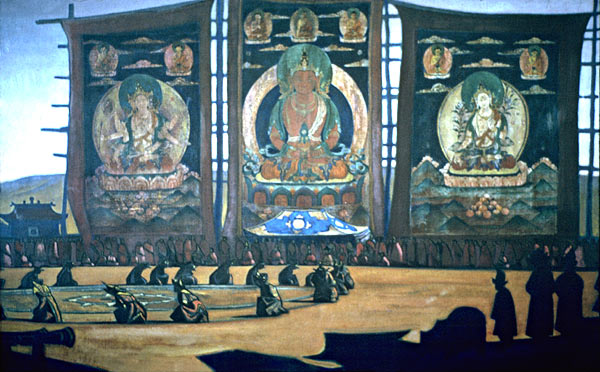Russian painter, writer, archaeologist, and philosopher, Nicholas Roerich was involved throughout his career with the problems of cultural preservation. From an early age, when, as a teen-age amateur archeologist in the north of Russia, he unearthed rare and beautiful ancient artifacts, he realized that the best products of humanity’s creative genius were almost always neglected, or even destroyed, by humanity itself.
In the earliest years of twentieth century, he traveled through the historic towns of Northern Russia, making paintings of their crumbling walls and deteriorating architecture. He then made appeals to the Russian government for efforts to maintain and restore these priceless links to the past.
Later it was the devastations of the first World War and the Russian revolution that spurred his own efforts. He came to realize that the cultural heritage of each nation is in essence a world treasure. And his idea of cultural heritage broadened to include more than just the physical remains of earlier cultures—the buildings and art, for example—but also the creative activities, the universities, the libraries, the hospitals, the concert halls and theaters. All must be protected from the ravages of war and neglect, for without them life would be nothing but a rude and ignorant time on earth.
It became clear to Roerich that an international effort was required. During the nineteen-twenties, he composed a treaty with the assistance of international legal experts. This treaty came to be known as The Roerich Pact.
The Roerich Pact and Banner of Peace movement grew rapidly during the early nineteen-thirties, with centers in a number of countries. There were three international conferences, in Bruges, Belgium, in Montevideo, Uruguay, and in Washington, D.C. The Pact itself declared the necessity for protection of the cultural product and activity of the world—both during war and peace—and prescribed the method by which all sites of cultural value would be declared neutral and protected, just as the Red Cross does with hospitals. Indeed, the Roerich Pact was often called The Red Cross of Culture.
Just as the Red Cross is embodied in a protective sign and banner, so does the Roerich Pact also designate a symbol—the one seen on this page—to be displayed on a banner, The Banner of Peace. This Banner, flown at all sites of cultural activity and historical value, would declare them neutral, independent of combatant forces.
The Banner of Peace symbol has ancient origins. Perhaps its earliest known example appears on Stone Age amulets: three dots, without the enclosing circle. Roerich came across numerous later examples in various parts of the world, and knew that it represented a deep and sophisticated understanding of the triune nature of existence. But for the purposes of the Banner and the Pact, Roerich described the circle as representing the totality of culture, with the three dots being Art, Science, and Religion, three of the most embracing of human cultural activities. He also described the circle as representing the eternity of time, encompassing the past, present, and future. The sacred origins of the symbol, as an illustration of the trinities fundamental to all religions, remain central to the meaning of the Pact and the Banner today.
The Roerich Pact was first agreed to by twenty-one nations of the Americas and signed as a treaty in the White House, in the presence of President Franklin Delano Roosevelt, on April 15, 1935, by all the members of the Pan-American Union. It was later signed by other countries also.
The year 2015 marks the eightieth anniversary of the signing of the Roerich Pact. The history of international treaties shows us how many of them were relevant and applicable to the times in which they were signed, but then lapsed into irrelevance. The Roerich Pact, however, has kept its heart and its life, and is linked to the needs of today’s chaotic world as much as ever.
The year 2015 marks the eightieth anniversary of the signing of the Roerich Pact. The history of international treaties shows us how many of them were relevant and applicable to the times in which they were signed, but then lapsed into irrelevance. The Roerich Pact, however, has kept its heart and its life, and is linked to the needs of today’s chaotic world as much as ever.
This content appears on the website of the Nicholas Roerich Museum.
For the text of The Roerich Pact, and of President Roosevelt’s message to the United States Congress on the occasion of its ratification, go here.
![kristof Gabriel carina van hooymissen [my ancestor lieven once brewed the beer saint-michael]](https://blogger.googleusercontent.com/img/b/R29vZ2xl/AVvXsEiuf5AId3Z3RVqmJkfVPVXsz_-LO89rYUHadTXsJnXUtENc6Q3DYO4cH6Ii3cJfHvIOyYLuyB4usNk9rXPfKXqGqnUPGe6D30imXQzsKAEvPnR478_6_CpifikjSMW-V0GLBp8BWPUB_B32/s250/Red+PIll.jpg)




Geen opmerkingen:
Een reactie posten